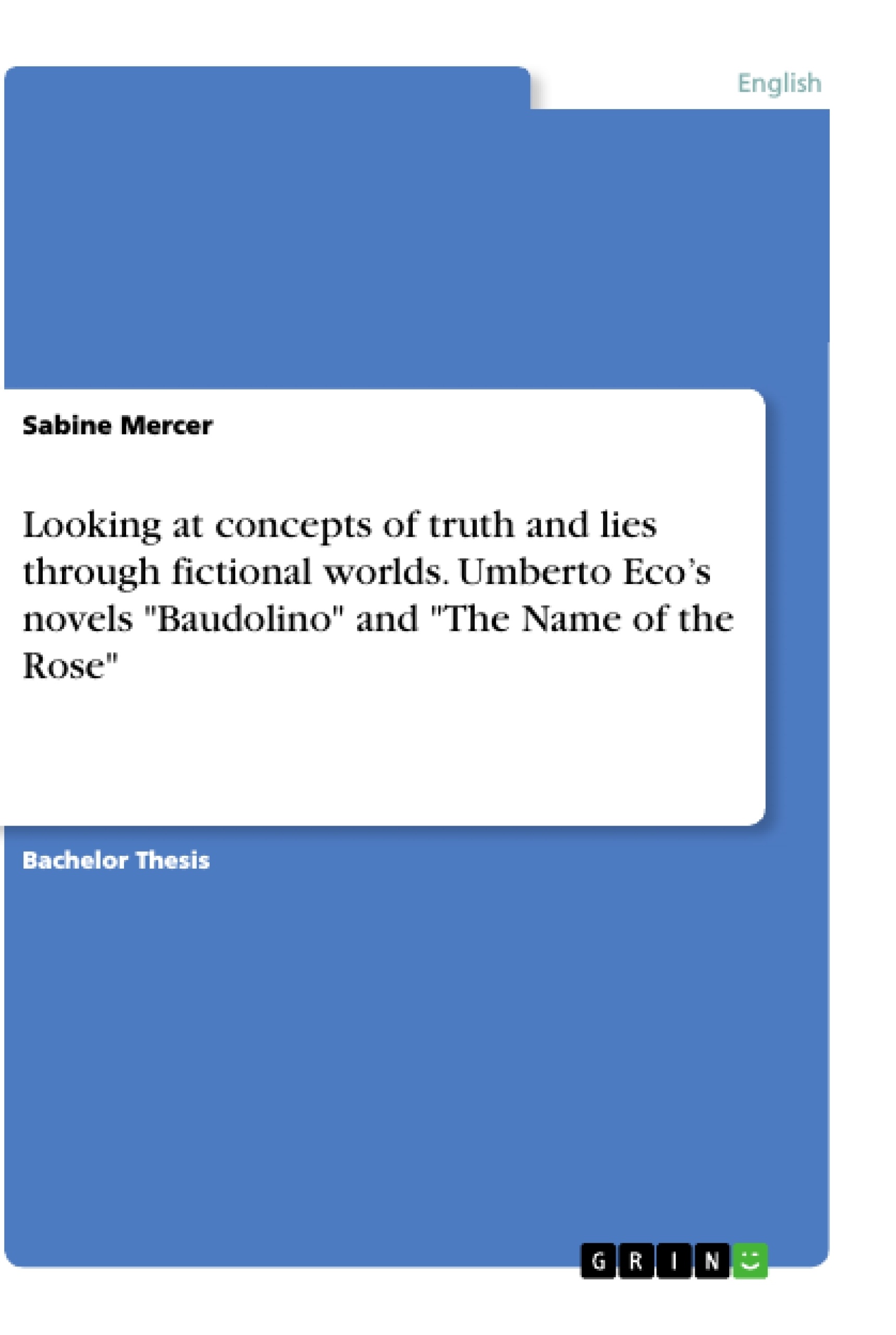The question then is, must we silence the irrational voices inside and outside and make an effort to understand the complexity of our existence to save us from chaos? Umberto Eco continues the tradition of philosophical novels, a genre in which scientific concepts, logic and knowledge form an essential part of the story. This thesis focuses on two of his novels "Baudolino" and "The Name of the Rose".
Not all knowledge-systems can be considered having equal value, but they all present competing frameworks. Whether we gain knowledge directly or indirectly, there are many different ways of knowing. It is part of the human condition to think that what feels to be true can exist independently of what we are told is true. What is of personal value we keep defending, even if we have to ignore facts or discredit contradictory arguments by labelling them as lies. No single theory can explain what we call ‘reality’, but we readily assume that reasoning and first-hand experiences are better guides than feeling. Still, the problem of self-deception looms large in appearances and judgements. His novels explore the interrelationship of belief, factual knowledge, differences between reality and perception, which can be subsumed under the categories of epistemology (the origin, nature, and limits of knowledge) and ontology (modes of experience, the categorical structure of reality, the nature or essence of individuals and objects). Both narratives are filled with examples that show the complexity of existence. When experience can be flawed and reasoning can lead to false conclusions, cautiousness and doubt should be applied. The medieval debate of ideas about the world and our place in it invites readers to reflect and to establish connections between the past and the present.
The connection between Eco’s postmodern meta fictions "The Name of the Rose" and "Baudolino" is illustrated in the light of Eco's numerous theoretical works. Both novels incorporate metaphysical and philosophical issues in a framework of fictionalized medieval controversies that engage with the nature of truth, justifications for a variety of beliefs, and the conceptual making of reality. The historical struggle between nominalism and realism, between totality and detail, and between empiricism and dogmatism, makes for a philosophical tour de force.
Inhaltsverzeichnis (Table of Contents)
- Introduction
- Chapter One: Creating Textual Worlds – Historiographic Metafiction.
- Encyclopaedia of knowledge
- Microcosm and heterocosm
- Intertextuality and anachronism
- Historical and fictional characters.
- Historical verisimilitude: chroniclers narrate
- Mixing different planes of reality.
- Creating a place for Prester John….....
- Vortex of interpretation versus dogmatic closure.
- Chapter Two: Political Power-Struggle over Truth-Claims – Cui bono?
- Rivalry between the state and the church…
- Secular and religious power based on forged letters .....
- Suppression of dissidents
- Subversive strategies: poverty debate, laughter and satire.
- Apocalypse: a new beginning or the end of everything?
- What and where is paradise – How does one get there?
- Chapter Three: Authority and Authenticity - Establishing and Controlling Truth-claims
- The Library preserves and conceals knowledge
- Heretics and Saints ..........\li>
- The network of textual knowledge.
- Unicorns or rhinoceros?
- Tradition has a social function
- The force of persuasion ...
- Suppressing alternative narratives.
- Chapter Four: Conceptual Making of Truth and Imagining Possibilities.
- Empiricism and science..\li>
- Possibility and desire are part of the future.
- Feelings and inner truth.
- Idealism and archetypes
- Relics and the importance of singularity.
- Symbolic ordering – signs and signifiers
- The emptiness of language....
- The conflict between universals and individuals
Zielsetzung und Themenschwerpunkte (Objectives and Key Themes)
This thesis investigates the philosophical and metaphysical themes explored in Umberto Eco's novels The Name of the Rose and Baudolino. By examining the authors' use of textual strategies and the interplay between historical knowledge and imaginative fiction, the study aims to understand how Eco presents different approaches to truth, knowledge, and reality.
- The role of truth in the construction of fictional worlds.
- The power struggles over truth-claims in medieval societies.
- The interplay between epistemology and ontology in Eco's novels.
- The manipulation of truth and knowledge for political and religious purposes.
- The impact of intertextuality and anachronism on the construction of historical verisimilitude.
Zusammenfassung der Kapitel (Chapter Summaries)
Chapter One analyzes Eco's unique blend of history and fiction, showcasing how his narratives engage with diverse elements of knowledge and reality. It explores the interweaving of historical and fictional characters, the use of chroniclers as narrators, and the deliberate destabilizing of the historical worlds within the novels.
Chapter Two delves into the struggle for power between the Church and the state in the medieval world, focusing on how each institution utilizes truth claims to advance its agenda. The discussion includes the significance of the poverty debate in The Name of the Rose and its role in exacerbating the internal conflict within the Church.
Chapter Three examines the ways in which authority and authenticity are established and controlled through the manipulation of knowledge. It explores the role of libraries in preserving and concealing knowledge, the power of tradition in shaping beliefs, and the suppression of alternative narratives.
Schlüsselwörter (Keywords)
Umberto Eco, The Name of the Rose, Baudolino, Historiographic Metafiction, Medieval World, Truth, Knowledge, Epistemology, Ontology, Intertextuality, Anachronism, Political Power, Church, State, Truth-Claims, Authenticity, Authority, Fictional Worlds, Historical Verisimilitude.
- Quote paper
- Dr. Sabine Mercer (Author), 2010, Looking at concepts of truth and lies through fictional worlds. Umberto Eco’s novels "Baudolino" and "The Name of the Rose", Munich, GRIN Verlag, https://www.grin.com/document/996574



